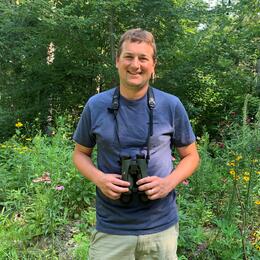The St. Louis River Estuary is a freshwater ecosystem and one of the largest tributaries that drains into Lake Superior. This area is designated as an Important Bird Area in Minnesota and Wisconsin and is one of the best sites for bird watching in both states. There are significant concentrations of waterfowl, shorebirds, waterbirds, passerines and raptors during spring and fall migration. The wetlands and associated shrub habitats of the area include breeding populations of Sedge and Marsh Wren, Alder Flycatcher, Sora, Virginia Rail, Swamp Sparrow, Chestnut-sided, and Yellow Warbler. Overall, there are more than 200 species that regularly use the area throughout the year, providing exciting opportunities to see new species along with your favorite birds! Despite all these birds, many locations within the estuary are not frequently visited by bird watchers, and we need more data! Please join us in helping to learn more about how exactly birds use this amazing location by getting out, watching, and recording birds that you see on eBird!
How to use eBird:
-
Create a free account
-
Take the eBird Essentials Course (optional)
-
Go birding and submit birding checklists!
Get involved:
Please focus birding efforts to collect data whenever possible during the spring, breeding, and fall migration periods in the St. Louis River Estuary at the “target sites”.
-
Visits during any time of year are encouraged, especially April through October.
-
Regular visits are highly encouraged!
-
Each visit should last at least 10 minutes and record all species detected.
-
Observations from within the habitat (i.e., from a kayak or canoe) are strongly encouraged. An emphasis on the river/marsh and shoreline areas is recommended.
-
All visits should be entered into eBird using the location’s hotspot (linked below).
-
This effort will help provide a comprehensive understanding of the dynamic nature of the bird communities in the St. Louis River and surrounding areas, especially during migration.
St. Louis River Estuary eBird Hotspots Needing Data
Allouez Bay, WI - https://ebird.org/hotspot/L386186
Park in any of the clearly-marked designated parking lots along Wisconsin Point and peer into the bay from the edge of the land or launch a canoe or kayak and explore all the nooks and crannies! Allouez Bay is one of the best places in the area to see breeding marshbird species such as Marsh Wren, Sora, American Bittern, or even Yellow-headed Blackbirds! Migratory waterfowl sometimes stages in the Bay.
Loon’s Foot Landing/Hog Island, WI - https://ebird.org/hotspot/L721859
Park in the large boat launch parking lot and scan the water from the launch and then walk along the Osaugie Trail in either direction. To the SE you will quickly reach a bridge over the Nemadji River. To the NW you will get good views of Hog Island and a small wetland between the trail and the island. Foot along path towards Hog Island and see migrant waterfowl in spring and fall along the river and in the wetlands and migrant songbirds in the woods and weedy fields.
Pokegama River, WI https://ebird.org/hotspot/L16280699
This is part of Dwight’s Point and Pokegama Wetlands State Natural Area. You can drive along Billings Drive, a seasonal access dirt road that winds along the Pokegama River and takes you through the Superior Municipal Forest. There are several pull-offs along the road where you can park and walk along the road. You might see migrant waterfowl in spring and fall along the river and in the wetlands and migrant songbirds in the woods and weedy fields.Billings Park, WI - https://ebird.org/hotspot/L567743
Many neighborhood roads wind through this area which borders the St. Louis River. Any locations near the river could yield good birding, but access is best at Billings Park on Billings 1st Point Rd (46.71357, -92.14427), a large pullout to the south of Billings Park on Billings Drive at Woodstock Bay, and the Arrowhead Public Boat Ramp to the north of Billings Park on Belknap St. Any of these access points could yield interesting migrating waterbirds in the St. Louis River including a variety of ducks, grebes, etc. The area is also prime for detecting migratory landbirds that migrate up the St Louis River and use the adjacent trees and shrubs for stopover habitat. Several species of warblers and other neotropical migrants breed in the wooded yards as well.
Chambers Grove, MN - https://ebird.org/hotspot/L5826046
Lovely City of Duluth Park. Park in the parking lot by the river or by the playground /pavilion. You can follow nicely constructed trails along the river and into the forest. You can see American White Pelicans stage on the island in the river each spring. Migrant warblers are often seen in the treetops. Common Mergansers and other ducks can be seen on the river. Cliff Swallows nest under the highway bridge.
Perch Lake, MN-https://ebird.org/hotspot/L1497731
Park in the small gravel lot next to the fishing pier. Scan the river on the south side of the road for waterbirds and carefully cross the road and scan Perch Lake from the north side (there is a small area to pull off on this side as well). Many waterbirds (notably large numbers of Trumpeter Swans) stage in this area during spring and fall. Large numbers of Rusty Blackbirds stage in this area in fall and sometimes dozens of Bald Eagles congregate on Perch Lake
Boy Scout Landing, MN - https://ebird.org/hotspot/L4434853
Park in the boat launch parking lot (plenty of spaces) and scan the river from the edge of the land. Foot from boat launch or canoe/kayak along river and you can see large numbers of dabbling ducks (especially Wood Ducks, and Green-winged Teal) that use this area of shallow water and emergent vegetation.




